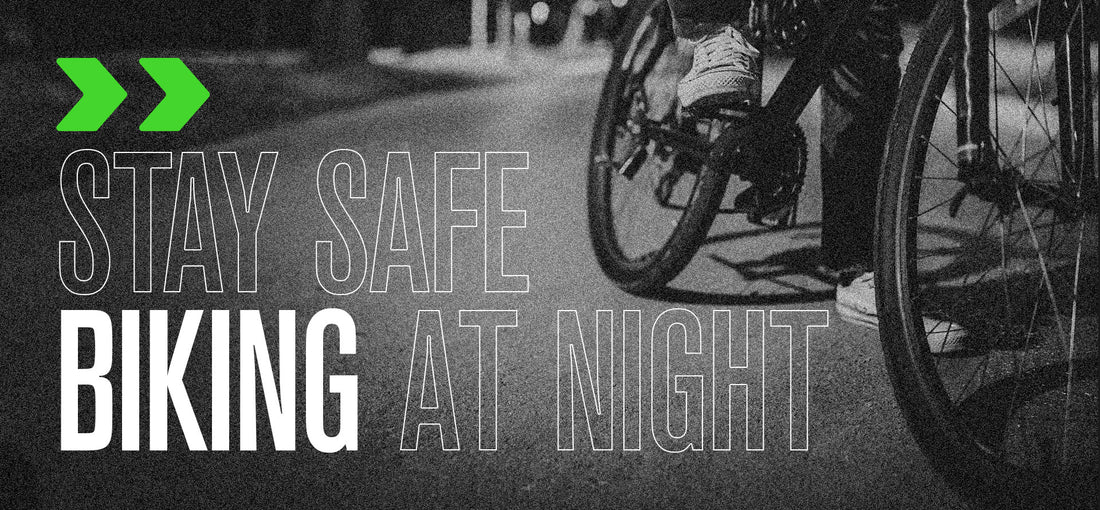Biking at night can be a ton of fun! But, like running at night, it comes with its own set of challenges and risks. To ensure your safety and visibility on the road when you’re cycling after dark, there are some things that are important to keep in mind. Whether you’re a seasoned cyclist or just starting to explore the joys of nighttime biking, here are 10 tips to help make your rides safer and more enjoyable.
1. Check your bike’s condition
Before you head out on your nighttime bike ride, it’s essential to make sure your bike is in good working order. You’ll want to pay special attention to your brakes, tires, and reflectors to avoid any potential issues – and you’ll want to do this regularly, as the condition of your bike will be affected by any riding you do. If it’s been a while since you’ve used your bike, consider taking it to a professional for a tune-up before you hit the road.
2. Choose well-lit routes
Depending on where you live, you might need to do a little planning to choose the best place for your midnight bike ride. Finding a well-lit path or street is almost always safer than the alternative of riding in the dark. A lighted route enhances your ability as a cyclist to see potential obstacles and hazards like potholes, debris, pedestrians, and other vehicles, reducing the risk of you having an accident.
Riding your bike in good lighting also increases your visibility to cars and other cyclists on the road, making you more noticeable. A well-lit cyclist is easier to see from a distance, allowing cars enough time to react to your presence and adjust their driving accordingly.
3. Use lights to your advantage
Using lights when biking at night is crucial for safety. Making sure your bicycle is properly illuminated is another way to ensure that drivers can spot you in the dark.
Lights can also help illuminate the road or path ahead, assisting you in identifying potential hazards. This helps with your ability to navigate safely and avoid accidents and injuries.
Moreover, using lights is a legal requirement in many areas, so it’s possible that you have to use them in order to stay within accordance with the law and avoid getting a ticket. You can use a search engine to find out what the laws in your area are regarding biking at night and cycling in general.
Some well-reviewed lights for bikers include Blackburn’s Luminate 360, which is a full lighting system for bikers that is recommended by the publication Bicycling. This set comes with front, rear and side lights that allow you to be seen from any angle. Blackburn points out on their website that the National Highway Traffic Safety Administration (NHTSA) has found that 27% of bicycle accidents are side impacts, which demonstrates the advantage of having more than just front and rear lights. The Luminate 360 set is micro-USB rechargeable and can last up to 6 hours on a charge, depending on which of the many available display options you choose to light your way.
For a headlight, Bicycling recommends the Gyhuego USB Rechargeable Light which produces up to 4000 lumens to light the way up to 1,640 feet ahead of you. This light can last up to 10 hours on a single charge in low brightness mode and up to 4 hours on a charge in high brightness mode.
4. Wear reflective clothing
Another way to increase your visibility when cycling at night is to wear reflective clothing.
Reflective clothing significantly increases the chance that motorists and other road users can see you on your bike, even when it’s dark out. Light from vehicle headlights or streetlights hits the reflective material and reflects back, making you more easily noticed. This, of course, greatly reduces the chances of accidents and improves overall road safety.
Reflective clothing can also help drivers determine your position and your distance from them, letting them judge your speed and react accordingly. Reflective clothing complements bike lights by providing an additional layer of visibility, and can act as a fallback if your lights run out of power or fail for any other reason. In fact, wearing reflective clothing may be a legal requirement where you’re riding, so be sure to check that when you’re reading up on other laws.
WildSpark offers reflective running clothing appropriate for any kind of athletic activity you want to undertake in the dark, including cycling.
5. Cover all the angles
Besides wearing reflective clothing, you should consider attaching reflective strips or accessories to various parts of your bike. This could include the pedals, wheels, and frame for maximum visibility from different angles.
The reflective tape you use doesn’t have to be specifically made for cyclists. One of the top-rated brands at Amazon is Kohree’s 2” reflective safety tape. This tape comes in 30’ rolls and can adhere to almost any surface. It’s UV resistant, so there are no worries if you store your bike outdoors.
6. Understand and obey the traffic rules
Understanding the laws governing bicycle riding is key to staying safe at any time of the day, but is especially important when you’re cycling after dark. If it’s been a while since you’ve reviewed the regulations in your area, be sure to give yourself a refresher before you set out for a nighttime bike ride.
7. Bike defensively
Adopting a defensive approach to biking means being vigilant, alert, and prepared for any potential hazards that might come your way. Anticipating the actions of motorists, pedestrians, and other cyclists lets you take proactive measures to mitigate risks like collisions and other dangerous situations.
It also means following traffic rules, maintaining a safe distance from vehicles, and making eye contact with drivers. By prioritizing safety and being aware of your surroundings, you can minimize the chances of an accident and make your biking experience generally safer and more enjoyable.
8. Use your signals
Just as you do during the daytime, you should use hand signals to indicate turns, stops and lane changes when you’re biking at night. Hand signals serve as a visual indication of your intentions as a cyclist, allowing motorists and pedestrians to anticipate your actions. By using hand signals, cyclists can enhance their visibility, improve communication, and contribute to overall road safety.
9. Keep distractions to a minimum
Since riding your bike at night is already inherently more dangerous than riding during the daytime, you should do everything you can to maintain your focus on safety and concentration on the road ahead.
Being fully attentive allows you to anticipate obstacles like pedestrians, vehicles, and animals, and react appropriately. Distractions like using a phone, listening to loud music or podcasts, using noise-canceling headphones, or engaging in other activities that divert your attention can limit your ability to perceive and react to these and other dangers.
Minimizing distractions helps you maintain control over your bike by allowing you to concentrate on your balance, speed, and maneuvering – all more critical in low-light conditions.
10. Carry identification
While it’s not fun to think about, accidents do happen. That’s why it’s important to always carry some form of identification and emergency contact information when you’re cycling at night, in case of unforeseen circumstances. While you can keep this information on your phone, it’s safer to have it elsewhere in case your phone is lost or disabled. It’s also a great idea to let someone know your planned route before you set out on your nighttime ride in case there’s an emergency.
Biking at Night FAQ
Here are the quick answers the most commonly asked questions about biking at night to supplement the information above:What are the laws around biking at night?
Different jurisdictions (generally at the state and city levels) will have at least some variations in their laws regarding cycling at night – and cycling in general. The best thing to do is to check your local laws to make sure you stay in compliance on your nighttime rides.
Googling “bicycling laws in [state]” and “bicycling laws in [city]” are usually going to be your best bet. For example, here are the laws in the State of Georgia.
What’s the best bicycle lighting option?
A lighting set that comes with front, rear and side lights is going to give you the very best protection when you’re cycling at night. Bicycling’s top pick is Blackburn’s Luminate 360, which is a full lighting system for bikers.What are the best reflectors for nighttime biking?
Reflectors are best used to supplement bike lights, not to replace them. That said, there are multiple options for bike reflectors, including front and back reflectors, pedal strips and tire spoke reflectors. You can learn more about reflectors for cycling at night here.
Biking at night can be a wonderful experience, but keep in mind that it’s crucial to prioritize your safety and take necessary precautions.
Checking your bike's condition regularly, choosing well-lit routes, and using lights to your advantage are all extremely important. Reflective clothing and accessories can significantly increase your visibility, helping you stand out to motorists and reducing the risk of accidents.
Once you’re on the road, understanding and obeying traffic rules, biking defensively, and using hand signals all contribute to your overall safety and effective communication. Keeping distractions to a minimum allows you to maintain focus and react swiftly to potential hazards.
Finally, carrying identification and emergency contact information ensures you’re prepared in case of unforeseen circumstances.
By adhering to these tips, you can make your nighttime bike rides safer, more enjoyable, and mostly worry-free. So grab your ride, gear up, and set out on a memorable adventure under the stars – while prioritizing safety every step (or wheel turn!) of the way. Happy biking!!!

